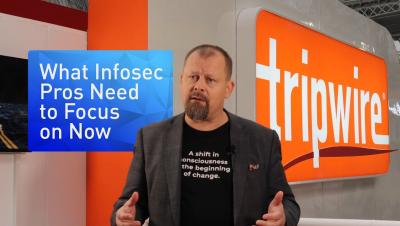Security | Threat Detection | Cyberattacks | DevSecOps | Compliance
July 2019
The 6 Top Tips of Things to Do at Black Hat USA 2019
Are you going to Black Hat USA 2019? If you are, you’re no doubt counting down the days until 3-8 August when you can join the thousands upon thousands of security professionals at the Mandalay Bay Resort and Casino in Las Vegas, Nevada. But if you’ve been to any of its other 21 iterations, you probably know that this conference can be a bit overwhelming if you don’t know what you’re doing. That’s why it’s good to go in knowing all that you can do as an attendee.
What Will Have the Greatest Impact on ICS Security in the Next 5-10 Years?
How Industrial Organizations Can Strengthen Their Security Posture
Most Security Pros Think Recent GDPR Fines Won't Significantly Affect Policies
In July 2019, UK Information Commissioner’s Office (ICO) announced its intention to fine two companies for violating the European Union’s General Data Protection Regulation (GDPR). ICO began by disclosing its intention to penalize British Airways in the amount of £183 million (approximately $224 million) on 8 July.
Woman arrested after Capital One hack spills personal info on 106 million credit card applicants
The FBI has arrested a 33-year-old software engineer in Seattle as part of an investigation into a massive data breach at financial services company Capital One. Paige A. Thompson, also known by the online handle “erratic,” has been charged with one count of computer fraud and abuse, after an investigation uncovered that a hacker had broken into cloud servers run by Capital One and stole data related to over 100 million credit-card applications.
NCSC Active Cyber Defence Report 2019: Evidence Based Vulnerability Management
On 16 July 2019, UK’s National Cyber Security Centre (NCSC) released the second annual report of the Active Cyber Defence (ACD) program. The report seeks to show the effects that the program has on the security of the UK public sector and the wider UK cyber ecosystem.
How Will Brexit Affect Cybersecurity for UK Organizations?
As a vendor, Tripwire gets asked a lot of questions from customers and potential clients about how developments in the wider world might affect digital security. One of those forces that’s on everyone’s mind is Brexit. Representatives from some of our potential customers as well as our existing clients are asking us what to focus on and what to do. Specifically, they’re wondering how Brexit will affect their digital security efforts in general.
Looking for Love in All the Wrong Places - AKA, the Cyber Security Talent Shortage
The subject of the cyber security talent shortage has been over-reported to the extent that no one wants to talk about it anymore. Even more than that, the only solution that really ever gets mentioned is developing more university cyber programs. But that solution is dead wrong—or at least it misses the crux of the issue completely.
Governors Association Says States Need Cyber Disruption Response
On July 11, 2019, the National Governors Association released a new publication on the topic of cyber disruption response plans across America. The report examines state cyber disruption response plans, providing recommendations for state officials who want to create or review their own response plans.
Using AWS Session Manager with Enhanced SSH and SCP Capability
Amazon Web Services recently announced new capabilities in the AWS Systems Manager Session Manager. Users are now capable of tunneling SSH (Secure Shell) and SCP (Secure Copy) connections directly from a local client without the need for the AWS management console. For years, users have relied on firewalls and bastion hosts in order to securely access cloud assets, but these options have security and management overhead tradeoffs.
The 4 Questions Industrial CISOs Need to Ask When Evaluating a Cybersecurity Tool
Cybersecurity is finally reaching the shop floor in earnest thanks to new technology that works with—not against—the legacy equipment that runs most industrial control systems (ICS). That being said, industrial companies and organizations in sectors like manufacturing, energy, utilities, transportation and water treatment can be slow to adapt to the new cybersecurity tools at their disposal because they present a new way of operating in an industry that’s set in its ways.
Six System and Software Vulnerabilities to Watch Out for in 2019
Wouldn’t it be an easier life if we didn’t have to worry about the exploitation of vulnerabilities in solutions and software on which we have spent good time and resources? A world where correctly configured systems configured were left alone to perform their functions until they became redundant and/or needed replacing? It is a beautiful dream. Sadly, it’s also a highly unrealistic one.
Cybersecurity Quick Tips: Kai Roer on What Security Professionals Need to Focus on Now
Cybersecurity Quick Tips: How to Get Started in Cybersecurity with Kai Roer
Multi-Cloud Security Best Practices Guide
A multi-cloud network is a cloud network that consists of more than one cloud services provider. A straightforward type of multi-cloud network involves multiple infrastructure as a service (IaaS) vendors. For example, you could have some of your cloud network’s servers and physical network provided by Amazon Web Services (AWS), but you’ve integrated that with your servers and physical networking that’s provided by Microsoft Azure.
Thousands of NHS computers are still running Windows XP from beyond the grave
Two years after the WannaCry ransomware outbreak shone a light on the computer security of the UK’s National Health Service, and five years after Microsoft said it would no longer release patches for Windows XP, the NHS still has 2300 PCs running the outdated operating system. The worrying statistic came to light in the response to a parliamentary question asked by shadow minister Jo Platt MP. The fact that 2,300 NHS computers are still running Windows XP is, obviously, not great news.
Communication - The Forgotten Security Tool
Security professionals have many tools in their toolbox. Some are physical in nature. (WireShark, Mimikatz, endpoint detection and response systems and SIEMs come to mind.) Others not so much. (These assets include critical thinking faculties, the ability to analyze complex processes, a willingness—some call it a need—to dig in and find the root cause of an issue and a passion to learn and keep learning.) One such tool that’s often overlooked is, communication.
Back to Basics: Infosec for Small and Medium Sized Businesses
Too many small and medium-sized businesses (SMBs) are under the belief that purchasing “This One Product” or “This One Managed Service” will provide all the security their network requires. If this were true, large corporations with huge IT budgets would never have data breaches! Before you start buying expensive new technology to protect your office network, take some time to examine your internal infosec processes. Make sure you are covering the basics.
Open Invitation to Help Develop Infosec Community Resources
It may be possible to democratize security by making it more accessible to average companies through community resources. We have an idea or two, but we would appreciate your thoughts.
U.S. Coast Guard Releases Cybersecurity Measures for Commercial Vessels
Have you ever seen the bridge of a commercial cargo shipping vessel? It is like a dream come true for every kid out there–a gigantic PlayStation. Unfortunately, maritime computer systems are also attractive to malicious cyber actors. Illustrating this interest by malicious individuals, the U.S. Coast Guard issued a safety alert warning all shipping companies of maritime cyber attacks.
Climbing the Vulnerability Management Mountain: Gearing Up and Taking Step One
As I discussed in the first blog in this series, the purpose of this series is to guide you on your journey up the Vulnerability Management Mountain (VMM). Like climbing a mountain, there is a lot of planning and work required, but when you get to the top, the view is amazing and well worth the journey. For the first phase, let’s start by planning the trip up Vulnerability Mountain. When you get ready to climb a mountain, you need gear, and you need to know what to ask for at the store.
Apple says its Walkie-Talkie app could be exploited to spy on iPhones
Apple has chosen to temporarily disable a key feature of the Apple Watch after a critical vulnerability was discovered that could allow someone to eavesdrop on another person without their knowledge. The Apple Watch feature at the heart of the problem is Apple’s Walkie-Talkie app which allows users to “push to talk” with other Apple Watch owners via a real-time voice message, rather than having to make a call or laboriously type a text message.
How Do You Protect Your Children When They Go Online?
When you are thinking about a very special holiday gift for your kid, one of the first things that spring to mind is a smartphone, tablet or laptop. It’s common knowledge that these devices aren’t very useful unless connected to the Internet. But how do you make sure your children are on the safe side when they go online? According to studies, kids spend more than nine hours a day surfing the web. That’s a lot of time, isn’t it?
New York Passes a Law that Further Expands Cyber Protection
The New York State Legislature recently passed a bill that aims to protect New York residents, regardless of the location of the business. The law, known as the Stop Hacks and Improve Electronic Data Security (SHIELD) Act is designed to address unauthorized access of data. The bill expands the definition of “Breach of the security of the system” by adding the wording “access to” data. The original regulation contemplated the acquisition of data.
British Airways faces record £183 million GDPR fine after data breach
What’s happened? British Airways is facing a record fine of £183 million, after its systems were breached by hackers last year and the personal and payment card information of around 500,000 customers were stolen. 183 million quid!? That sounds huge! Yes, it’s the biggest fine ever handed out by the UK’s Information Commissioner’s Office (ICO).
How to Leverage DevOps and Automation to Bolster Security
Speed and security. Old-fashioned thinking contended that the two were incompatible; that high-velocity development and deployment of apps and software services invariably introduced higher levels of risk. However, it has become increasingly apparent that speed is a necessary aspect of security. The stakes are sky-high, with some estimates projecting that the annual cost of cybercrime losses and damage will reach $6 trillion by 2021.
4 Fundamentals That Make Your Vulnerability Management (VM) Program Less Effective
If you are a security practitioner, then you may have noticed that much of the security industry exists because of vulnerabilities. Regardless of what job position you occupy, vulnerabilities are oftentimes the reason why you wake up every morning and ultimately engage infosec from within your cutting-edge working environment. Vulnerabilities will continue to arise; this is a fact of the environmental change that goes with any business or organization.
SOX - Not Just for Foxes and Baseball; A Sarbanes-Oxley IT Compliance Primer
There are Red Sox, White Sox, and Fox in Socks. At the turn of the century, a new SOX entered our lexicon: The Sarbanes-Oxley Act of 2002. This financial regulation was a response to large corporate misdeeds at the time, most notably Enron misleading its board through poor accounting practices and insufficient financial oversight. The regulation seeks to ensure accurate and reliable financial reporting for public companies in the United States.
End Users as the Strongest Link
“It’s okay that you don’t understand.” This comment came after I was frustrated with myself for not being born a genius at math. Usually, when you don’t know a subject or you don’t understand it enough, subject matter experts (i.e. your teachers/professors/mentors/etc) put you down for it. But this time was different because I had a real subject matter expert who cared about the end goal: students educated in math.







